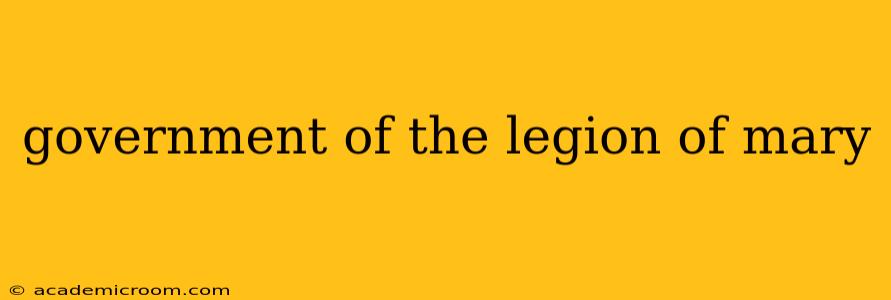The Legion of Mary is a lay Catholic organization known for its extensive network of volunteers dedicated to evangelization and service. Understanding its governance structure is crucial to appreciating its global reach and effectiveness. While the Legion operates with a hierarchical structure, it emphasizes collaboration and teamwork in its mission. This post delves into the governing bodies of the Legion of Mary, clarifying its organizational framework and answering common questions.
What is the highest governing body of the Legion of Mary?
The highest governing body of the Legion of Mary is the Council of the Concilium. This international body provides overall direction and guidance for the entire organization. It's composed of representatives from various regions, ensuring a global perspective in decision-making. Its role is to safeguard the Legion's spiritual identity and ensure uniformity in its practices across the world.
What is the role of the Concilium in the Legion of Mary?
The Concilium's responsibilities are multifaceted. It acts as a central point of authority, interpreting the Legion's spiritual handbook, Handbook of the Legion of Mary, and providing clarifications on its practices. It oversees the development and implementation of Legion programs globally, ensuring consistency and high standards of spiritual formation for its members. Additionally, it approves the establishment of new councils and oversees the administration of the Legion's overall operations. Essentially, the Concilium is the keystone of the Legion's global structure.
What are the different levels of government in the Legion of Mary?
The Legion of Mary’s organizational structure is hierarchical, mirroring a somewhat military-like structure with clear lines of command and responsibility. The structure generally flows as follows:
- Praesidium: This is the foundational unit of the Legion, the local level group of members meeting regularly for prayer, planning, and sharing experiences.
- Comitium: A grouping of several Praesidia within a particular geographic area, usually a city or town.
- Regia: Oversees several Comitia within a larger region, typically a diocese or province.
- Concilium: The highest governing body, encompassing the entire global Legion.
Each level has its own council or governing body responsible for the leadership and administration within its jurisdiction. This ensures that the Legion's activities are well-organized and coordinated at each level, from the local Praesidium to the international Concilium.
How are leaders chosen in the Legion of Mary?
Leadership positions within the Legion of Mary are based on election and appointment, guided by spiritual qualities and suitability. Members are typically chosen for their demonstrated commitment to the Legion's spiritual ideals and their ability to lead and motivate others. The process varies slightly depending on the level of governance, but a general emphasis is placed on prayerful discernment and choosing individuals with proven dedication and spiritual maturity.
Who is responsible for the spiritual formation of Legionaries?
Spiritual formation is a central pillar of the Legion of Mary. While individual members are responsible for their personal spiritual growth, various levels of the Legion's governing structure play a vital role in fostering this growth. Spiritual directors, often priests, provide guidance and support. Furthermore, regular meetings at each level, including the Praesidium, Comitium, Regia, and Concilium, often include spiritual reflections, prayers, and discussions aimed at deepening the members' faith and commitment. The emphasis on spiritual formation permeates every aspect of the Legion's hierarchical structure.
This overview provides a general understanding of the Legion of Mary's government. The specific details of its operation may vary slightly in different regions. However, the hierarchical structure, emphasizing collaboration and spiritual growth, remains consistent in its aim to serve the Church and its communities globally.
